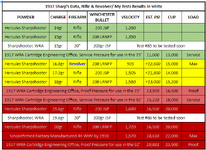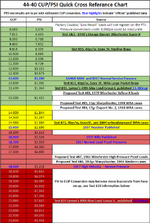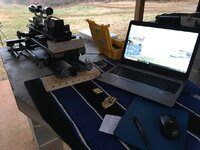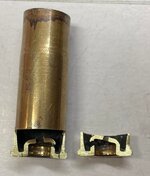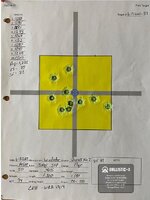- Messages
- 42
- Reactions
- 49
With all the pressure testing that has been done over the past few years, I have decided to conduct at least 8 more tests. With what we do have now, there is enough data to show a relative linage between CUP and PSI now for the 44-40. We still have a few missing links that could use some closure that will be tested soon.
I tried to simplify what I have done the best I could in the following charts. These charts are always subject to updates based on better and more reliable data and are subject to change without notice. As always, any information below is not intended to be used as actual load data and is for discussion purposes only.
They can be seen here: Click the tabs at the bottom of the charts. If the format is not working good, here is a direct link.
While there may not be any pressure data easily available for original black powder loads prior to 1917, WRA's 1917 dated Cartridge Engineering Office documented 13,000cup service pressures and 16,500 Proof Pressures, for use in the Winchester 73'. It can only be assumed WRA is referring to smokeless powder charges since many of the included cartridges are only smokeless powder cartridges. The Service Pressure directly relates to this particular powder and load for this cartridge. Why, keep in mind that Winchester's first offered 1895 loads through 1925, all used a charge of Dupont No. 2 rifle powder. Original charges indicate 17gr with some at 16gr. Some cartridge examples show a charge as low as 15gr. Handload information of the time also offer charges 17gr and 16gr.
Winchester never advised again the use of these Dupont No. 2 loads (1895 to 1925) in any Winchester 73', regardless of year manufactured. Winchester did advised they not be used in revolvers between about 1900 and 1909.
Winchester switched from Dupont No.2 from to Sharpshooter powder by 1926 and to ball powders by 1949 and to a disk powder by 1979. Winchester always showed a velocity of 1,300fps from it's 1895 introduction through 1950, when the velocity increased to 1,310fps about the time Winchester switched to ball powders. Velocity dropped to 1,190fps advertised when Winchester switched to disk powders around 1979.
For years I have seen reports to indicate that the 44 High Velocity loads (not for use in the Winchester 73' or revolvers) produced 22,000cup. However, a WRA, February 14th, 1917 document may indicate otherwise. It looks as if the WRA Cartridge Engineering Office documented 18,000cup service pressures and 23,500cup Proof Pressures for the 44 W.H.V cartridge . Looking at cartridge examples from the Draw Set I have to late production, the only component that looks to have changed is the primer. The WRA "Balloon Pocket" inside the case appears to be the same through the late 1930's. The powder charge dropped from 20gr down to 13.9 in some examples while the velocities advertised an increase. From 1,500fps in 1903, to 1,564 by 1925 and to 1,570fps by 1938.
Simply put, Winchester loaded their cartridges to Service Pressure loads, but over time they seem to downgrade performance, and lower the charges to a include a safety margin. Many rifles manufactured had bores that ranged from as small as .422" (documented), and as large as .433". "Max" loads from the factory did not seem to be reduced until the late 1970's. Some 1980's handloading manuals showed loads using .430" bullets used in a .436" bore.
Sharp's 1937 "Sharpshooter Powder" handloading data does not indicate a "max" load but lists loads that exceed 13,000cup as well as 18,000cup loads. Loads with a Service Pressure of 13,000cup are listed but pressures not noted. Load pressures of 14,000cup and higher are listed and noted. Winchester started using Sharpshooter powder in 1903 for their 44 WHV loads but switched from Dupont No. 2 to Sharpshooter by 1926 for all 44-40 smokeless loads.
Testing the Sharpshooter loads and Dupont No. 2 loads will not be easy and several obstacles could hinder accurate results. Cases used will be period cases but new primers will be used as well as the Winchester JSP and .424" lead bullets where needed.
I have conducted 83 tests, reverified two (Buffalo Bore loads and Winchester Factory loads) as well as added one more to the list as Test 90. By next week I hope to add 8 or 9 more to include the original powder factory loads.
With the above tests results, if successful, the below charts can be updated to give even better data and cup/psi comparisons for a historical understanding. Hopefully we can get a better idea what the 1914 era HV loads actually produced as well as 1914 era 44 W.H.V. loads.
Pressure Testing data can be seen here
or
directly by clicking here
Pressure Curve comparisons can be seen here
There is tons of data and information the the 44-40 website here





I tried to simplify what I have done the best I could in the following charts. These charts are always subject to updates based on better and more reliable data and are subject to change without notice. As always, any information below is not intended to be used as actual load data and is for discussion purposes only.
They can be seen here: Click the tabs at the bottom of the charts. If the format is not working good, here is a direct link.
While there may not be any pressure data easily available for original black powder loads prior to 1917, WRA's 1917 dated Cartridge Engineering Office documented 13,000cup service pressures and 16,500 Proof Pressures, for use in the Winchester 73'. It can only be assumed WRA is referring to smokeless powder charges since many of the included cartridges are only smokeless powder cartridges. The Service Pressure directly relates to this particular powder and load for this cartridge. Why, keep in mind that Winchester's first offered 1895 loads through 1925, all used a charge of Dupont No. 2 rifle powder. Original charges indicate 17gr with some at 16gr. Some cartridge examples show a charge as low as 15gr. Handload information of the time also offer charges 17gr and 16gr.
Winchester never advised again the use of these Dupont No. 2 loads (1895 to 1925) in any Winchester 73', regardless of year manufactured. Winchester did advised they not be used in revolvers between about 1900 and 1909.
Winchester switched from Dupont No.2 from to Sharpshooter powder by 1926 and to ball powders by 1949 and to a disk powder by 1979. Winchester always showed a velocity of 1,300fps from it's 1895 introduction through 1950, when the velocity increased to 1,310fps about the time Winchester switched to ball powders. Velocity dropped to 1,190fps advertised when Winchester switched to disk powders around 1979.
For years I have seen reports to indicate that the 44 High Velocity loads (not for use in the Winchester 73' or revolvers) produced 22,000cup. However, a WRA, February 14th, 1917 document may indicate otherwise. It looks as if the WRA Cartridge Engineering Office documented 18,000cup service pressures and 23,500cup Proof Pressures for the 44 W.H.V cartridge . Looking at cartridge examples from the Draw Set I have to late production, the only component that looks to have changed is the primer. The WRA "Balloon Pocket" inside the case appears to be the same through the late 1930's. The powder charge dropped from 20gr down to 13.9 in some examples while the velocities advertised an increase. From 1,500fps in 1903, to 1,564 by 1925 and to 1,570fps by 1938.
Simply put, Winchester loaded their cartridges to Service Pressure loads, but over time they seem to downgrade performance, and lower the charges to a include a safety margin. Many rifles manufactured had bores that ranged from as small as .422" (documented), and as large as .433". "Max" loads from the factory did not seem to be reduced until the late 1970's. Some 1980's handloading manuals showed loads using .430" bullets used in a .436" bore.
Sharp's 1937 "Sharpshooter Powder" handloading data does not indicate a "max" load but lists loads that exceed 13,000cup as well as 18,000cup loads. Loads with a Service Pressure of 13,000cup are listed but pressures not noted. Load pressures of 14,000cup and higher are listed and noted. Winchester started using Sharpshooter powder in 1903 for their 44 WHV loads but switched from Dupont No. 2 to Sharpshooter by 1926 for all 44-40 smokeless loads.
Testing the Sharpshooter loads and Dupont No. 2 loads will not be easy and several obstacles could hinder accurate results. Cases used will be period cases but new primers will be used as well as the Winchester JSP and .424" lead bullets where needed.
I have conducted 83 tests, reverified two (Buffalo Bore loads and Winchester Factory loads) as well as added one more to the list as Test 90. By next week I hope to add 8 or 9 more to include the original powder factory loads.
With the above tests results, if successful, the below charts can be updated to give even better data and cup/psi comparisons for a historical understanding. Hopefully we can get a better idea what the 1914 era HV loads actually produced as well as 1914 era 44 W.H.V. loads.
Pressure Testing data can be seen here
or
directly by clicking here
Pressure Curve comparisons can be seen here
There is tons of data and information the the 44-40 website here
